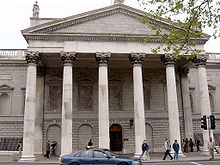Irish House of Lords
Irish House of Lords | |
|---|---|
the monarch or inheritance of a peerage | |
| Meeting place | |
 | |
| Lords Chamber, Parliament House, Dublin | |
| Footnotes | |
| 1In 1800 See also: Parliament of Great Britain |

The Irish House of Lords was the upper house of the Parliament of Ireland that existed from medieval times until the end of 1800. It was also the final court of appeal of the Kingdom of Ireland.
It was modelled on the
History
The Lords started as a group of barons in the Lordship of Ireland that was generally limited to the Pale, a variable area around Dublin where English law was in effect, but did extend to the rest of Ireland. They sat as a group, not as a separate House, from the first meeting of the Parliament of Ireland in 1297. From the establishment of the Kingdom of Ireland in 1542 the Lords included a large number of new Gaelic and Norman lords under the policy of surrender and regrant.
Religious division was reflected in the House, but as late as the 1689 "
By the 1790s most of the Lords personified and wanted to protect the "
Following the
Today the 18th-century
, and visitors can view the Irish House of Lords chamber within the building.Function
The Parliament of Ireland was a
The Lords was the highest
The House of Lords was presided over by the
Sessions were generally held at
-
A sectional engraving of the House of Lords chamber (by Peter Mazell 1767 based on the drawing by Rowland Omer)
-
The Woolsack was used by the Lord Chancellor when chairing the house
-
William III's victory over James II/VII
The Battle of the Boyne tapestry that hangs in the Lords chamber -
Charles Manners, 4th Duke of Rutland lying in state in the Irish House of Lords chamber after his death in 1787
See also
Footnotes
- JSTOR 175512.
- ^ E.M. Johnson-Liik History of the Irish parliament in 6 vols. (Belfast, 2002).
- ^ "The Irish Peers and the House of Lords - The final chapter". Burke's Peerage. Archived from the original on 19 August 2010.




